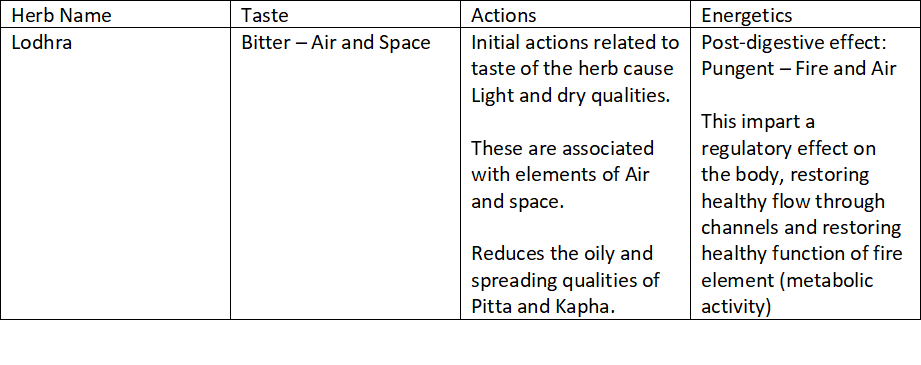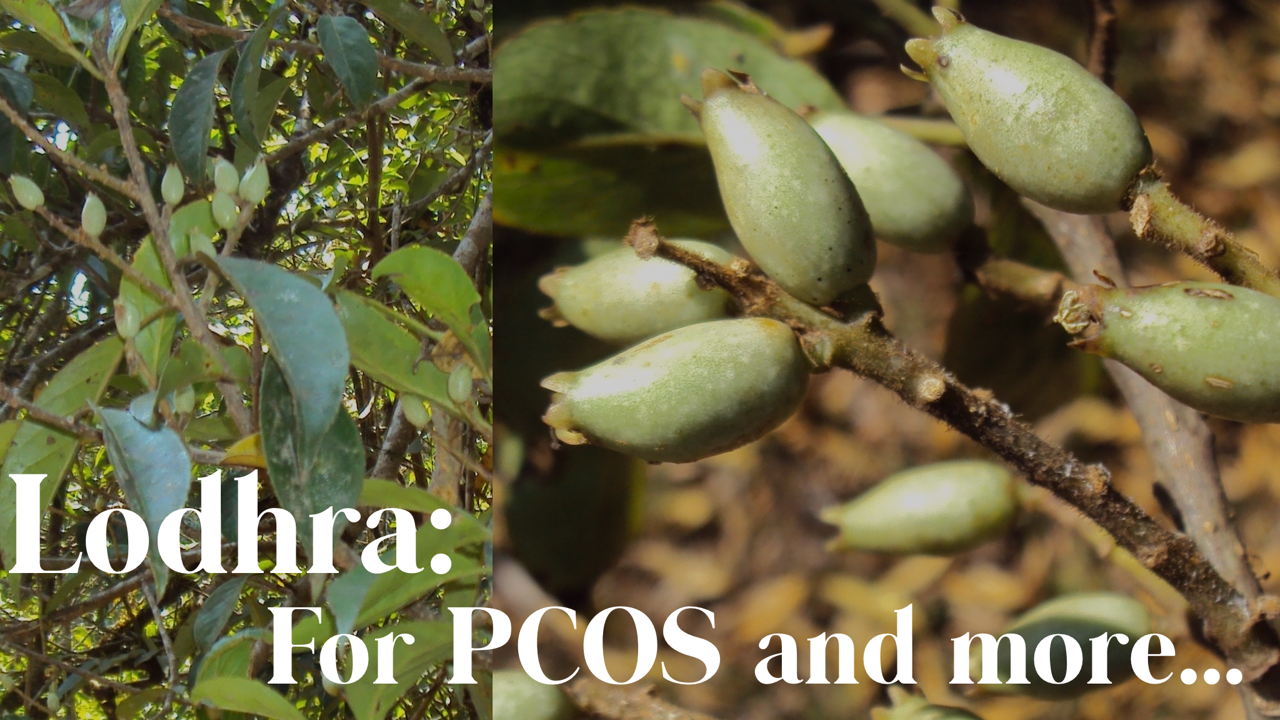
Reference text:
Bhavaprakarasha Vol. 1: Haritakiyadi chapter: Absorbs excess dampness in the system, causes dryness. It Reduces excess flow associated with bleeding, diarrhea, general edema, as well as improve eye function.
Special indications for the Vaidya (Physician): reducing bleeding associated with hemorrhoids, bowel injury, diarrhea, and menorrhagia (excess menstrual bleeding) in association with dampness of kapha and secondary inflammation (Pitta aggravation). Swellings with dull pain in an inflamed state. Also, bleeding, oozing secretions associated with skin diseases.
Research reference:
1) Reducing testosterone: Testosterone is an androgen – It has an anabolic building effect on the body tissues. When it is abnormally high it causes dampness with trapped heat. Lodhra with the light and drying effect provide the perfect contrast to these qualities. In conjunction with this, Lodhra has been shown to lower testosterone levels, while restoring estrogens, progesterone and cholesterol levels.1 This action makes it effective PCOS-like conditions with Kapha/Pitta aggravations.
2) Controlling menstrual bleeding: Excessive menstrual bleeding associated Kapha/pitta symptoms like swelling and heat in the body through PMS, dull pain, bright red blood, etc. is a good indication of Lodhra. A traditional formulation called Lodhra Asavam has proven clinically effective in lowering symptoms: reducing the volume of blood, days of bleeding, as well as discomfort.2 One of the mechanisms of this action controlling excess blood vessel formation.3
3) Improving Metabolism: The post-digestive effect of Lodhra is described as pungent, associated with the fire and air element. This effect appear contradictory to the light and drying qualities of the herb itself. However, Lodhra is a proven restorative of the metabolic system. In addition to the effect on hormonal metabolism discussed above, Lodhra has proven liver-protective function4, doing this by restoring liver anti-oxidants, glutathione, super-oxide dismutates, catalase, etc. It also reduces cholesterol levels by activating cholesterol metabolism in the liver.5 This activity has been shown reduce total cholesterol, LDL (“bad” cholesterol) and triglycerides, while increasing HDL (“good” cholesterol).
4) Anti-diarrheal effect: Bitter taste with its associated light and drying qualities, help to reduce excess inflammation and fluid in the bowels. This anti-inflammatory activity is observed in studies through Lodhra’s capacity to reduce inflammation associated-edema.6 Combining this with mild anti-bacterial7 and anti-parasitic8 activities of the herb, it is found to be very useful supportive herbs in conditions that involve infectious and non-infectious loose bowels that are associated with symptoms of Kapha/pitta aggravation – like dull pain, bleeding, burning sensations, general swelling, dullness/drowsiness, heaviness, fever, heat, etc.
Conclusion:
The hallmark symptoms PCOS show very definitive indication of Kapha and Pitta aggravations. Kapha aggravations indicated by increased weight due to slow metabolism, insulin resistance, cysts, and acne. Pitta aggravations are indicated by testosterone increase, increased facial hair, male-pattern hair loss, excess menstrual bleeding, and acne. Actions of Lodhra provide both functional and symptomatic relief in this condition. Combining Lodhra with other ayurvedic herbs, provides powerful tool for individualizing treatment of such Kapha-pitta aggravations.
Research references:
Mamta Jhadav, Sasikumar Menon, Sunita Shailajan. Anti – androgenic effect of Symplocos racemosa Roxb. against letrozole induced polycystic ovary using rat model. Journal of Coastal Life Medicine 2013; 1(4): 309-314.
Devi, K Prameela. Clinical evaluation of Pushyanuga Choorna and Lodhrasava in Rakta Pradara (DUB). Indian Journal of Traditional Knowledge, Vol. 6(3), July 2007, PP. 429-431.
Hussain, S.J. Gaffney, N. Ahmed, M.Slevin and M.I. Ahoudhary et. al.2009; Investigation of the kinetic and anti-angiogenic properties of plant glycoside inhibitors of thymidine phosphorylase.; J. Asian. Nat. Prod. Res. 11:159-167
Wakchaure D., D. Jain, A.K. Singhai and R. Somani, 2010. Hepatoprotective activity of symplocos racemosa bark on carbon tetrachloride-induced hepatic damage in rats; J. Ayurveda Intregative Med., 2:137-143.
A.M.Durkar, R.R. Patil, S.R. Naik; Hypolipidemic and antioxidant activity of ethanolic extract of symplocos racemosa Roxb. In hyperlipidemic rats. Indian Journal of Experimental Biology vol.52; jan 2014, pp. 36-45.
Rajendran Vadivu and K.S. Lakshmi; In vitro and in vivo anti-inflammatory activity of leaves of Symplocos cochinchinensis(Lour) Moore ssp laurina. Journal of Bangladesh Pharmacological Society (BDPS), 2008; 3:121-124.
M.R. Khan, M. Kihara, A.D. Omoloso. Antimicrobial activity of Symplocos cochinensis, Fitoterapia, 72(2001) 825-828.
Narsimha Rao R.L. Bhavy B., Pavani K., Swapna A., Prasoona C.H.; Anthelminthic activity of Symplocos racemosa. International Journal of Pharmacy and Biological Sciences, 1, 3, 2011, 198-230.




